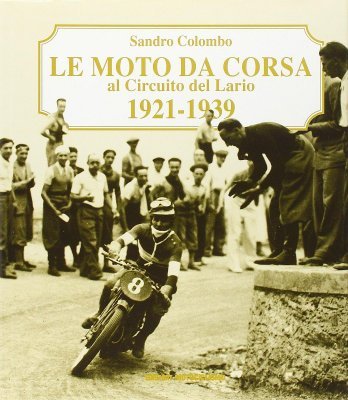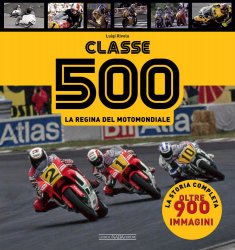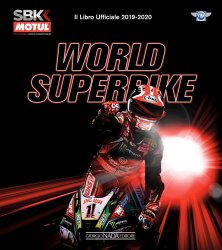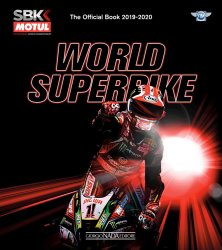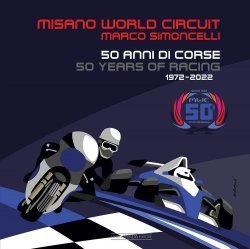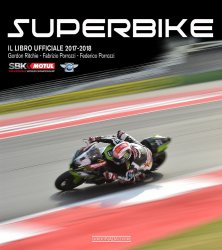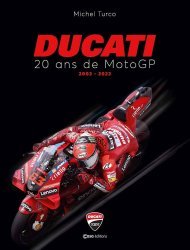The transition in competition from elaborate series production motorbikes to those specially designed for racing use took place gradually in the two decades between World Wars.
The birth and evolution of the large competition models are linked to the sales-driving function of some famous races and the consequent importance given by motorbike manufacturers to this form of promotion.
The types of competitions of these years were essentially based on three basic types: races on high-speed circuits; races on mixed circuits with particularly difficult tracks; and long-distance road races.
In Italy, if Monza is the classic example of races of the first type, and the Milano-Napoli (later Milano-Taranto) and the Giro d'Italia are for road races, the Circuito del Lario - called the Italian Tourist Trophy because of its difficulty - was undoubtedly the most difficult closed-circuit race in Italian motorcycling for twenty years.
The difficulties of the track (a 36.5-kilometre ring to be repeated six or seven times with three hundred curves per lap and a 550-metre difference in altitude between the part along the lake and Ghisallo Pass), the beauty of the places and the date of implementation have made it not only the most important Italian motorbike race, but also an unmissable appointment of the sporting summer.
The most prestigious motorbikes and the best-known champions of the time have passed through Lario, hence the choice of the history of the Lario Circuit as the basic plot for a wide-ranging discourse on the development of motorbike technology between the two wars.
A subject that, complete with biographies of the most famous champions of the time, unfolds through a series of technical notes and a collection of monographs of the motorbikes that marked the most important steps in the development of motorbike technology.
Le moto da corsa al Circuito del Lario 1921-1939, published in 1991, has 367 pages and a rich iconographic collection that completes Sandro Colombo's excellent text.
Product specification
Additional information
Write a Review
Login or Register to write your review
You might also like
- Publisher: Giorgio Nada
- Language: Italian
- Binding : In hardback
- Publisher: Giorgio Nada
- Language: Italian
- Binding : In paperback
- Publisher: Cdm Edizioni
- Language: Italian
- Binding : In hardback
- Publisher: Giorgio Nada
- Language: English
- Binding : In hardback
- Publisher: Giorgio Nada
- Language: Italian
- Binding : In paperback
- Publisher: Casa Editions
- Language: French
- Binding : In hardback
Per offrirti la miglior esperienza di navigazione possibile www.gilena.it utilizza i cookie. Vedi Informativa completa.
Preferenze sui cookie
Cookie essenziali
Utilizzati per le funzionalità vitali del sito, per garantire un esperienza utente ottimale
Cookie opzionali
Per funzionalità relative al marketing, alle statistiche e tutte quelle non ritenute essenziali
-
Shop by Category
Shop by Category
- Bus
-
Cars
Cars
- View all: Cars
- American cars
-
By marque
By marque
- View all: By marque
- Abarth
- Ac
- Alfa romeo
- Allard
- Alpine
- Alvis
- Alvis
- Amc
- Amilcar
- Amx
- Armstrong siddeley
- Asa
- Aston martin
- Ats
- Auburn-cord
- Audi
- Austin
- Austin healey
- Auto union
- Autobianchi
- Ballot
- Bentley
- Bianchi
- Bizzarrini
- Bmc
- Bmw
- Bolwell
- Bond
- Borgward
- Brabham
- Bristol
- Brm
- Bsa
- Bucciali
- Bugatti
- Buick
- Cadillac
- Chaparral
- Chenard & walker
- Chevelle
- Chevrolet
- Chevron
- Chrysler
- Citroen
- Cooper
- Cord
- Corvette
- Crossle
- Cunningham
- Daewoo
- Daf
- Daimler
- Dallara
- Datsun/nissan
- Db
- De dion-buton
- De lorean
- De soto
- De tomaso
- Delage
- Delahaye
- Diatto
- Dkw
- Dodge
- Duesenberg
- Edsel
- Elva
- Era
- Ermini
- F.a.t.a.
- Facel vega
- Farman
- Ferrari
- Fiat
- Ford
- Frazer nash
- Gaz
- Giannini
- Ginetta
- Glas
- Gm
- Gordini
- Gta
- Henney
- Hillman
- Hispano - suiza
- Hommell
- Honda
- Horch
- Hotchkiss
- Hudson
- Humber
- Impala
- Imperial
- Innocenti
- Isorivolta
- Isotta fraschini
- Itala
- Jaguar
- Jensen
- Jowett
- Koenigsegg
- Lagonda
- Lamborghini
- Lancia
- Lea-francis
- Lexus
- Life racing engines
- Limousine
- Lincoln
- Lola
- Lotus
- March
- Marcos
- Martini
- Maserati
- Matra
- Maybach
- Mazda
- Mclaren
- Mep
- Mercedes
- Mercury
- Messerschmitt
- Metro
- Mg
- Minerva
- Mini
- Mitsubishi
- Monica
- Morgan
- Morris
- Nash
- Nissan
- Nota
- Nsu
- Oldsmobile
- Om-iveco
- Opel
- Packard
- Pagani
- Panhard
- Panoz
- Panther
- Parnelli
- Pegaso
- Peugeot
- Pilain
- Pininfarina
- Plymouth
- Pontiac
- Porsche
- Puch
- Railton
- Range rover
- Reliant
- Renault
- Riley
- Rolls royce
- Rover
- Royale
- S.p.a.
- Saab
- Salmson
- Sauber
- Schweizer
- Seat
- Shelby
- Simca
- Singer
- Skoda
- Standard
- Steyr
- Studebaker
- Subaru
- Sunbeam
- Talbot
- Tatra
- Tecno
- Thunderbird
- Tiger
- Toyota
- Trabant
- Triumph
- Tvr
- Van diemen
- Vanwall
- Vauxhall
- Vedette
- Venturi
- Voisin
- Volkswagen
- Volvo
- Wanderer
- Wartburg
- Westfield
- Williams
- Willys
- Wolseley
- Car shows and museums
- Cars for kids
-
Coachbuilding, styling & design
Coachbuilding, styling & design
- View all: Coachbuilding, styling & design
- Alfa romeo
- Antem
- Asa
- Autodelta
- Bertone
- Bertoni flaminio
- Bmw
- Boneschi
- Brawand dany
- Campana
- Carcerano piero luigi
- Chappe & gessalin
- Chapron henri
- Charbonneaux philippe
- Cisitalia
- Colani luigi
- Colani lutz
- De tomaso
- Exner virgil
- Fioravanti leonardo
- Fissore
- Frua pietro
- Ghia
- Gilco
- Giugiaro
- Hebmuller
- Kellner
- Lancia
- Mantegazza
- Martin paolo
- Mathis emile
- Mays j
- Mercedes
- Michelotti giovanni
- Monteverdi
- Moretti
- Nissan
- Pininfarina
- Renault
- Reutter
- Riva
- Saab
- Saoutchik
- Sartorelli
- Sbarro franco
- Scaglietti
- Scioneri
- Siata
- Spada
- Stanguellini
- Touring
- Toyota
- Vignale
- Viotti
- Volkswagen
- Welter gerard
- Zagato
- Comics and drawings
- Yearbooks
- Collectibles
- Dvd & vhs
-
Manuals - technical books
Manuals - technical books
-
Military vehicles
Military vehicles
- Modelling
-
Motor sport and racing
Motor sport and racing
- View all: Motor sport and racing
-
Cars
Cars
- View all: Cars
- Aintree
- Autodromo di franciacorta
- Autodromo di pergusa
- Bahrain
- Birmingham
- Boavista
- Brands hatch
- Bridgehampton
- Brno
- Brooklands
- Buenos aires
- Can am
- Carrera panamericana
- Castle combe
- Charade
- Circuito del garda
- Circuito del jarama
- Circuito del mugello
- Circuito del valentino
- Circuito di cremona
- Circuito di lasarte
- Circuito di modena
- Circuito di napoli
- Circuito di pescara
- Circuito di piacenza
- Circuito di rouen les-essarts
- Coppa acerbo
- Coppa della perugina
- Coppa etna
- Coppa gordon bennett
- Coppa paolino teodori
- Corse in salita
- Dieppe
- Formula 1
- Formula 2
- Formula 3
- Formula 3000
- Formula 5000
- Formula ford
- Formula junior
- Francorchamp
- Giro di sicilia
- Goodwood
- Gran premi belgio
- Grand prix
- Hockenheim
- Imola
- Indianapolis
- Interlagos
- Kart
- Le mans
- Macau
- Martini racing
- Mille miglia
- Mintex
- Montjuic
- Montlhery
- Monza
- Nascar
- Nassau
- Nurburgring
- Oulton
- Paul-ricard
- Penya rhin
- Phillip island
- Rally
- Reims
- Sebring
- Silverstone
- Solitude
- Stock car
- Targa florio
- Tasman cup
- Thruxton
- Torrey pines
- Trans-am
- Vallelunga
- Vila real
- Westwood
- Zandvoort
- Zolder
- Motorcycles
- Paris-dakar
- Record
-
Motorcycles
Motorcycles
- View all: Motorcycles
-
By marque
By marque
- View all: By marque
- Aermacchi
- Ajs
- Ajs & matchless
- Ape
- Aprilia
- Ardie
- Ariel
- Benelli
- Beta
- Bimota
- Bmw
- Brough superior
- Bsa
- Bultaco
- Cagiva
- Ccm
- Cz
- Demm
- Derbi
- Dkw
- Douglas
- Ducati
- Egli
- Frera
- G.d
- Ganna
- Garelli
- Gilera
- Gitane
- Gori
- Guzzi
- Harley davidson
- Hercules
- Honda
- Horex
- Husqvarna
- Indian
- Jap
- Jawa
- Kawasaki
- Kreidler
- Ktm
- Lambretta
- Laverda
- Maico
- Maserati
- Matchless
- Mba
- Mm
- Mondial
- Monet goyon
- Montesa
- Morbidelli
- Morini
- Motobecane
- Mv agusta
- Mz
- Neftali ollearo
- Norton
- Nsu
- Opel
- Ossa
- Panther
- Parilla
- Peugeot
- Piaggio
- Puch
- Royal enfield
- Rudge
- Rumi
- Sanglas
- Sarolea
- Scott
- Sertum
- Sunbeam
- Suzuki
- Terrot
- Triumph
- Velocette
- Vespa
- Victory
- Vincent
- Wanderer
- Yamaha
- Zundapp
- Chopper
- Comics and drawings
- Sidecar
- Trike
- Yearbooks
- Off road
- Other subjects
-
Personality & driver
Personality & driver
- View all: Personality & driver
-
Car drivers
Car drivers
- View all: Car drivers
- Alboreto michele
- Alen markku
- Alesi jean
- Amon chris
- Andretti mario
- Ascari
- Bandini ilario
- Bandini lorenzo
- Barrichello rubens
- Bell derek
- Berger gerhard
- Biason miki
- Brabham jack
- Burns richard
- Caracciola rudolf
- Castellotti
- Clark jim
- Conrero
- Coulthard david
- Courage piers
- Darniche bernard
- De filippis maria teresa
- De Portago
- Dean james
- Fangio
- Fittipaldi emerson
- Frentzen heinz-harald
- Gurney dan
- Hakkinen mika
- Hawthorn mike
- Hill damon
- Hill graham
- Hunt james
- Ickx jacky
- Laffite jacques
- Lauda niki
- Loeb sebastien
- Mairesse willy
- Mansell nigel
- Marzotto
- Mckay david
- Mclaren bruce
- Mcqueen steve
- Mcrae colin
- Montoya juan pablo
- Moss stirling
- Musso luigi
- Nardi
- Nesti mauro
- Nuvolari tazio
- Peterson ronnie
- Pilette
- Piquet
- Pironi didier
- Prost alain
- Ragnotti jean
- Rainey joy
- Regazzoni clay
- Reutemann carlos alberto
- Rindt jochen
- Rohrl walter
- Rondeau jean
- Rosemeyer
- Rosier louis
- Russell jim
- Sainz carlos
- Sartarelli francesco
- Schumacher michael
- Scott brown archie
- Seaman richard
- Senna ayrton
- Serafini dorino
- Stewart jackie
- Stohl rudi
- Stohr siegfried
- Taruffi piero
- Toivonen henri
- Trips wolfgang von
- Vaccarella nino
- Varzi achille
- Villeneuve gilles
- Villeneuve jacques
- Villoresi luigi
- Von hanstein huschke
- Wimille jean-pierre
- Zanardi alex
- Magazines
-
Motorcycle drivers
Motorcycle drivers
- View all: Motorcycle drivers
- Agostini giacomo
- Anderson hugh
- Ballington kork
- Bandirola carlo
- Bayliss troy
- Benelli tonino
- Bergamonti angelo
- Biaggi max
- Bianchi edoardo
- Bianchi pier paolo
- Britten john
- Buscherini otello
- Capirossi loris
- Cau giuseppe
- Conti vittorio
- Dobb jamie
- Duke geoff
- Dunlop joey
- Dunlop robert
- Edwards colin
- Ermolenko sam
- Everett reg
- Finnegan martin
- Fogarty carl
- Gritti alessandro
- Hailwood mike
- Hannah bob
- Ivy bill
- Lazzarini enzo
- Lomas bill
- Lorenzo jorge
- Lucchinelli marco
- Mandracci guido
- Marquez marc
- Masetti umberto
- Mcgrath jerry
- Mcintyre bob
- Meier georg
- Miller sammy
- Muller egon
- Neumann-neander ernst
- Ostorero emilio
- Parlotti gilberto
- Pasolini renzo
- Penhall bruce
- Provini tarquinio
- Rainey wayne
- Read phil
- Rossi valentino
- Ruffo bruno
- Seeley colin
- Sheene barry
- Simoncelli marco
- Spencer freddie
- Stoner casey
- Surtees john
- Tenni omobono
- Testori imerio
- Vincent arnaud
- Wilkinson arthur george
- Personality
-
Tractors & caterpillar
Tractors & caterpillar
- View all: Tractors & caterpillar
- Caterpillar
-
Tractors by marque
Tractors by marque
- View all: Tractors by marque
- Allgaier
- Allis-chalmers
- Bubba
- Caterpillar
- Cletrac
- Cockshutt
- David brown
- Deutz
- Eicher
- Farmall
- Ferguson
- Fiat
- Ford
- Fordson
- Hanomag
- Hart-parr
- Holt
- International harvester
- J.i. case
- John deere
- Kramer
- Landini
- Lanz
- Marshall
- Massey
- Minneapolis-moline
- Nuffield
- O.m.
- Oliver
- Perkins
- Porsche
- Renault
- Same
- Steyr
- Tractractor
- Twin city
- Trucks
- [ Gift Cards ]
- New Releases
- Special Offers
-
Latest Additions
Latest Additions
- coming soon
- Events
- Account
-
Information
Information
Limited Stock Books
We generally have one or more copies of this book available: they may be in perfect condition or with some signs of wear, the price may vary depending on the state of conservation.
Please, contact us for information on the state of conservation and the selling price of this product.




